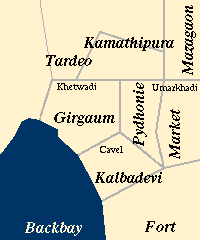Mumbai
Quick links

See also the overview of the Inner City.
The word Mazagaon has been derived from the Sanskrit Matsya Gram, meaning fishing village. However, folk etymology derives it from the Marathi Maza Gaon, meaning my village. One of Mazagaon's oldest claims to fame was a variety of mango trees which fruited twice a year. Apparently a few such trees were extant well into the twentieth century. The small island was rocky, with a hill rising at the north, and forming a cliff over the harbour. To see what Mazagaon might once have been, one has to visit any of the tiny rocky islands bearing mango trees and small villages further down the Konkan coast.
The first Portuguese settlers were the Jesuits, who established a church sometime in the sixteenth century. Notwithstanding their claim, in 1572 the King of Portugal granted the island in perpetuity to the de Souza e Lima family, from whom the D'Souzas of Bombay trace their descent. When the Portuguese ceded the island to the British, there was a well established population of Roman Catholics, mainly fishermen. Most were Hindu converts, although Eurasians were not uncommon. Some black African slaves brought by the Portuguese, known as Kaffirs had also entered the ethnic mix. Some of their traditional wooden houses can still be seen, and are now protected heritage structures.
C17 The original Gloria church, Nossa Senhora de Gloria, was built in 1632 from a donation by the de Souza family. It was destroyed in 1911, and two years later a new, standard issue Gothic, church of the same name was built a kilometer away.
Mazagaon was occupied by the Sidi of Janjira, an admiral in the Mughal navy in 1690. It is said that he was driven away a year later by the Rustomji Dorabji, who organised the fishermen in Dongri into a fleet. Rustomji was given the title Patel after this feat, and his descendants remain the only Parsi family of Patels till now.
C18 With the reclamation of Umarkhadi, at the end of the seventeenth century, Mazagaon became an outlying suburb of Bombay and a fashionable place to live in. One of the famous houses was the neo-classical Tarala, built by a member of the Wadia family in the late eighteenth century. Sold to the Jeejeebhoy family about a century later, it became the Sadar Adalat in 1925, when they moved out to Malabar Hill. Later still it was taken over by the army, and then donated to the J. J. Hospital in 1943 after a fire. It was used as a staff hostel for a few years before it was demolished.
Other bungalows and plantations also grew up in Mazagaon as the British and the more affluent Indians moved out of the crowded fort. When the Esplanade was cleared in the Fort area, the armoury moved from Bombay Castle to Mazagaon in 1760 and gave its name to Gunpowder Lane. In 1790 the docks at Mazagaon were completed. In 1793, after the construction of the Hornby Vellard, the Bellasis Road was built to join Mazagaon and Malabar Hill.
C19 The next century saw a slow decline in Mazagaon's fortunes, as the neighbouring Bycullah became the fashionable suburb, and people began moving out. The process accelerated after the docks were reclaimed in the last thirty years of the century on the eastern shore of Mazagaon. Mazagaon was left landlocked, and the fumes from the developing mills drove the last money out of this area.
C20 In the twentieth century, Mazagaon has become a working class area, deep within the crowded heart of the city. There is a large Catholic population still living here, although the Muslim population of neighbouring Umarkhadi and Mandvi has spread northward.